|
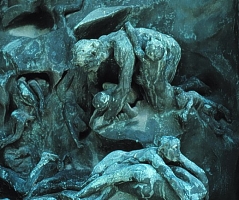 In Book
XXXIII of the 'Divine Comedy', Dante presents the story of Ugolino della Gherardesca, Count of Donoratico, head of a faction of the
pro-Papal Guelphs in Pisa during the 13th Century. In order to seize power in the town
governed by Nino of Gallura, head of the opposing faction, Ugolino had entered a pact with Archbishop Ruggieri degli
Ubaldini, leader of the Ghibelline (pro-Holy Roman Emperor) faction. In
the summer of the year 1288 Nino and his men were expelled from the city. In Book
XXXIII of the 'Divine Comedy', Dante presents the story of Ugolino della Gherardesca, Count of Donoratico, head of a faction of the
pro-Papal Guelphs in Pisa during the 13th Century. In order to seize power in the town
governed by Nino of Gallura, head of the opposing faction, Ugolino had entered a pact with Archbishop Ruggieri degli
Ubaldini, leader of the Ghibelline (pro-Holy Roman Emperor) faction. In
the summer of the year 1288 Nino and his men were expelled from the city.
When a new Pope appeared on the scene, Ubaldini denounced the
alliance and - now that the Guelphs were weakened - accused Ugolino of
corruption. Charging the Count for having assisted Florence and Lucca to
win back some towns that had previously been conquered by Pisa, he brought
up the population against Ugolino. The tyrant along with two sons and two grandsons
(or nephews, in other versions) were imprisoned in the Gualandi Tower
overlooking Pisa's central Piazza dei Cavalieri. In March 1289, on the arrival of Count Guido da Montefeltro
(described in Canto XVII), as Captain of Pisa, they were starved to death. Since then the tower has been called
Torre della
Fame, the Tower of Hunger.
According to the popular tale, Ugolino, racked with hunger, ate the flesh of
his children as last survivor. By now, scientific research, based on
excavations in the Gherardesca family tomb, has
questioned if the 'Cannibal Count' actually consumed human flesh during
his last days [Read more].
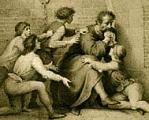 In the 'Divine Comedy', Dante meets Ugolino in the
lowest region of Hell, gnawing the skull of his former friend, then fiend
Ubaldini: because both men were guilty of treachery, they were condemned
to eternal punishment in the ninth Circle of Hell, reserved for traitors.
Dante hears Ugolino's tragic account how after two days, he had bitten his hands in
remorse and
despair while his sons - thinking he was doing so for hunger - had offered their
own young bodies as a meal to him: In the 'Divine Comedy', Dante meets Ugolino in the
lowest region of Hell, gnawing the skull of his former friend, then fiend
Ubaldini: because both men were guilty of treachery, they were condemned
to eternal punishment in the ninth Circle of Hell, reserved for traitors.
Dante hears Ugolino's tragic account how after two days, he had bitten his hands in
remorse and
despair while his sons - thinking he was doing so for hunger - had offered their
own young bodies as a meal to him:
|
Come un poco di raggio si fu messo
nel doloroso carcere, ed io scorsi
per quattro visi il mio aspetto stesso,
ambo le mani per dolor mi morsi.
Ed ei, pensando ch' io 'l fessi per voglia
di manicar, di subito levorsi,
e disser: `Padre, assai ci fia men doglia,
se tu mangi di noi: tu ne vestisti
queste misere carni, e tu le spoglia.'
|
When a small ray was sent into
the doleful prison, and I discerned in their
four faces the aspect of my own,
I bit on both my hands for grief. And they,
thinking that I did it from desire of
eating, of a sudden rose up,
and said: 'Father, it will give us much less
pain, if thou eat of us: thou put upon us
this miserable flesh, and do thou strip it off.'
|
|
[Read full text and
English translation]
|
|
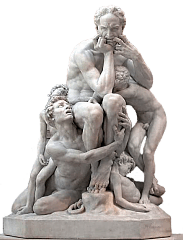 This is the
scene Carpeaux - like other artists before him - had selected for his
sculpture 'Ugolino', exhibited at the Salon of 1863.
In the same year, Rodin had joined the
Union Centrale des Arts
Décoratifs and - impressed by Carpeaux's
work - had tried to socialize with the successful sculptor, who did not
return his sympathy. This is the
scene Carpeaux - like other artists before him - had selected for his
sculpture 'Ugolino', exhibited at the Salon of 1863.
In the same year, Rodin had joined the
Union Centrale des Arts
Décoratifs and - impressed by Carpeaux's
work - had tried to socialize with the successful sculptor, who did not
return his sympathy.
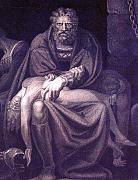 Almost surely inspired by Carpeaux's design with a sitting Ugolino, Rodin began his first draft of 'Ugolino and his sons' probably already in
1876. Rodin made over 30 sketches
; two of these drawings, probably dating
from 1879-1880, show a seated Ugolino with one of his sons lying across
his lap. Claudie Judrin and subsequently Albert Elsen point to
Michelangelo's Pietà, viewed by Rodin in 1875, as an
art-historical reference and interpret these sketches as evidence of
Buonarotti's strong influence
Almost surely inspired by Carpeaux's design with a sitting Ugolino, Rodin began his first draft of 'Ugolino and his sons' probably already in
1876. Rodin made over 30 sketches
; two of these drawings, probably dating
from 1879-1880, show a seated Ugolino with one of his sons lying across
his lap. Claudie Judrin and subsequently Albert Elsen point to
Michelangelo's Pietà, viewed by Rodin in 1875, as an
art-historical reference and interpret these sketches as evidence of
Buonarotti's strong influence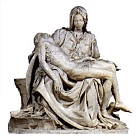 .
The painting 'Ugolino' (1806) by Johann Heinrich Fussli (1741-1825), now
in the Kunsthaus Zürich, proves that at least Rodin was not the only
artist recurring to the Pietà concept for a portrait of the
starving Count. .
The painting 'Ugolino' (1806) by Johann Heinrich Fussli (1741-1825), now
in the Kunsthaus Zürich, proves that at least Rodin was not the only
artist recurring to the Pietà concept for a portrait of the
starving Count.
After
his journey to Italy, where he had seen, among others, the famous 'Laocoon'
group in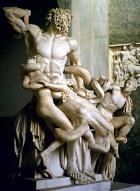 Rome
- another work dealing with the cruel death of a father
and his two sons - Rodin destroyed the seated version of his 'Ugolino'
sculpture;
the plaster was
reduced to a headless fragment,
that survived in this form and was shown again in Rodin's private
exhibition pavillon at the Place d´Alma in 1900. This sitting
character with its peculiarly crossed legs can be considered the morphological forerunner of the 'Thinker', Rome
- another work dealing with the cruel death of a father
and his two sons - Rodin destroyed the seated version of his 'Ugolino'
sculpture;
the plaster was
reduced to a headless fragment,
that survived in this form and was shown again in Rodin's private
exhibition pavillon at the Place d´Alma in 1900. This sitting
character with its peculiarly crossed legs can be considered the morphological forerunner of the 'Thinker',
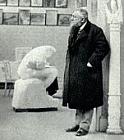 which Rodin developed around 1880.
Other relevant studies of male seated figures can be found in Rodin's 'Vase
of the Titans', created during his employment at the Sèvres Porcelain
Manufactury.
which Rodin developed around 1880.
Other relevant studies of male seated figures can be found in Rodin's 'Vase
of the Titans', created during his employment at the Sèvres Porcelain
Manufactury.
Whereas the third maquette for 'The
Gates of Hell' still
shows a seated Ugolino, Rodin's following attempts present the desperate sinner
at the climax of the drama as related to Dante:
|
Poscia che fummo al quarto dì
venuti,
Gaddo mi si gittò disteso a' piedi,
dicendo: `Padre mio, chè non m'
aiuti
Quivi morì; e come tu mi vedi,
vid' io cascar li tre ad uno ad uno
tra il quinto dì e il sesto: ond' io mi
diedi
già cieco a brancolar sopra
ciascuno,
e due dì li chiamai poi che fur
morti;
poscia, più che il dolor, potè il
digiuno."
|
When we had come to the fourth day, Gaddo
threw himself stretched out at my feet,
saying: 'My father! why don't you help me?'
There he died; and as thou seest me, saw
I the three fall one by one, between the fifth
day and the sixth: whence I betook me,
already blind, to groping over each, and for
two days called them, after they were dead;
then fasting had more power than grief."
|
|
[Read full text and
English translation]
|
|
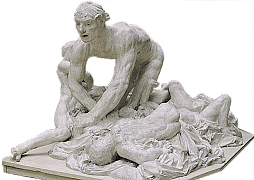 Instead of repeating the
traditional pyramidal construction,
employed by Carpeaux, Rodin around 1881-82 introduced a daring horizontal composition showing the
exhausted old man on all fours, blindly groping for his suffering
progenity. The plaster in the Musée d'Orsay shows Ugolino still with a
raised head; in the final version, included in 'The Gates of Hell',
the sculptor goes the last step: the Count is facing down like an animal, no longer able to
maintain a reflective distance; as a last human gesture, his left arm is supporting the head of his dying son, the other son
still clinging to his father's back. Instead of repeating the
traditional pyramidal construction,
employed by Carpeaux, Rodin around 1881-82 introduced a daring horizontal composition showing the
exhausted old man on all fours, blindly groping for his suffering
progenity. The plaster in the Musée d'Orsay shows Ugolino still with a
raised head; in the final version, included in 'The Gates of Hell',
the sculptor goes the last step: the Count is facing down like an animal, no longer able to
maintain a reflective distance; as a last human gesture, his left arm is supporting the head of his dying son, the other son
still clinging to his father's back.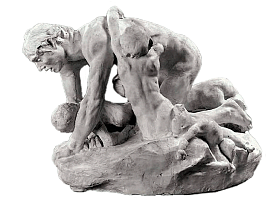
Trumann Bartlett - a sculptor himself - recognized the radical
pathetic quality of this composition:
"Rodin goes at once to the depths of the whole tragedy.
The youths have fallen to the ground, and Ugolino, seeing them so, and
feeling the full terror of his situation, throws his own emaciated carcass
down and crawls over the body of his offspring like a beast benumbed with
rage and famine... The impression made by this being is so forcible that
it seems more like the half-conscious response of an unburied corpse to
the trumpet of the resurrection... It is the horror of the door"
[Bartlett]
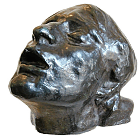 The group,
first placed on the left panel of the 'The Gates of
Hell', around 1887 was moved to the right wing, where it remained. The group,
first placed on the left panel of the 'The Gates of
Hell', around 1887 was moved to the right wing, where it remained.
Rodin himself was so convinced of his creation, that he detached the head of one of the sons,
and enlarged it seperately in different
media; this
'Head of Sorrow' was used for Paolo in 'Fugit
Amor'; it also was exhibited as an indepent sculpture and carved
in marble.
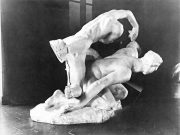 During the 1890's, Rodin created an assemblage of the
'Ugolino' character with 'The Tragic Muse'. During the 1890's, Rodin created an assemblage of the
'Ugolino' character with 'The Tragic Muse'.
In 1906, he started with the enlargement of the
'Ugolino' group. René Chéruy related how Rodin had invited Pignatelli,
who had been his model for the first version, to come and see him on that
occasion. Upon arrival at the Villa des Brillants where Rodin was
having luncheon with guests, old Pignatelli announced himself to Rodin's
confused housekeeper as 'St John the Baptist'. Rodin, who had forgotten
the appointment, understood some mentally insane beggar had knocked on his
door and ordered to give the poor man some food, till a persistent
Pugnatelli could convince the maid and Rodin he was the sculptor's former
model.
|

 In the 'Divine Comedy', Dante meets Ugolino in the
lowest region of Hell, gnawing the skull of his former friend, then fiend
Ubaldini: because both men were guilty of treachery, they were condemned
to eternal punishment in the ninth Circle of Hell, reserved for traitors.
Dante hears Ugolino's tragic account how after two days, he had bitten his hands in
remorse and
despair while his sons - thinking he was doing so for hunger - had offered their
own young bodies as a meal to him:
In the 'Divine Comedy', Dante meets Ugolino in the
lowest region of Hell, gnawing the skull of his former friend, then fiend
Ubaldini: because both men were guilty of treachery, they were condemned
to eternal punishment in the ninth Circle of Hell, reserved for traitors.
Dante hears Ugolino's tragic account how after two days, he had bitten his hands in
remorse and
despair while his sons - thinking he was doing so for hunger - had offered their
own young bodies as a meal to him:


 .
The painting 'Ugolino' (1806) by Johann Heinrich Fussli (1741-1825), now
in the Kunsthaus Zürich, proves that at least Rodin was not the only
artist recurring to the
.
The painting 'Ugolino' (1806) by Johann Heinrich Fussli (1741-1825), now
in the Kunsthaus Zürich, proves that at least Rodin was not the only
artist recurring to the  Rome
- another work dealing with the cruel death of a father
and his two sons - Rodin destroyed the seated version of his 'Ugolino'
sculpture;
the plaster was
reduced to a headless fragment,
that survived in this form and was shown again in Rodin's private
exhibition pavillon at the Place d´Alma in 1900. This sitting
character with its peculiarly crossed legs can be considered the morphological forerunner of the
Rome
- another work dealing with the cruel death of a father
and his two sons - Rodin destroyed the seated version of his 'Ugolino'
sculpture;
the plaster was
reduced to a headless fragment,
that survived in this form and was shown again in Rodin's private
exhibition pavillon at the Place d´Alma in 1900. This sitting
character with its peculiarly crossed legs can be considered the morphological forerunner of the 
 Instead of repeating the
traditional pyramidal construction,
employed by Carpeaux, Rodin around 1881-82 introduced a daring horizontal composition showing the
exhausted old man on all fours, blindly groping for his suffering
progenity. The plaster in the Musée d'Orsay shows Ugolino still with a
raised head; in the final version, included in
Instead of repeating the
traditional pyramidal construction,
employed by Carpeaux, Rodin around 1881-82 introduced a daring horizontal composition showing the
exhausted old man on all fours, blindly groping for his suffering
progenity. The plaster in the Musée d'Orsay shows Ugolino still with a
raised head; in the final version, included in 

 During the 1890's, Rodin created an assemblage of the
'Ugolino' character with
During the 1890's, Rodin created an assemblage of the
'Ugolino' character with